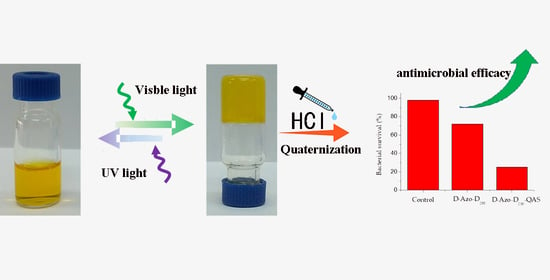Azobenzene Based Photo-Responsive Hydrogel: Synthesis, Self-Assembly, and Antimicrobial Activity
Abstract
:1. Introduction
2. Results and Discussion
2.1. 1H NMR Analysis
2.2. Gelation Ability
2.3. Thermo Response
2.4. Light Response
2.5. Antimicrobial Activity
3. Conclusions
4. Materials and Methods
4.1. Materials and Methods
4.2. Synthesis of D-Azo-D230 and D-Azo-D230-QAS
4.3. Biocompatibility of the Hydrogels
4.4. Antimicrobial Activity Pretreatments
Author Contributions
Funding
Institutional Review Board Statement
Informed Consent Statement
Data Availability Statement
Acknowledgments
Conflicts of Interest
References
- Zou, L.; Addonizio, C.J.; Su, B.; Sis, M.J.; Braegelman, A.S.; Liu, D.; Webber, M.J. Supramolecular hydrogels via light-responsive homoternary cross-links. Biomacromolecules 2021, 22, 171–182. [Google Scholar] [CrossRef]
- Ha, W.; Zhao, X.B.; Zhao, W.H.; Tang, J.J.; Shi, Y.P. A colon-targeted podophyllotoxin nanoprodrug: Synthesis, characterization, and supramolecular hydrogel formation for the drug combination. J. Mater. Chem. B 2021, 9, 3200–3209. [Google Scholar] [CrossRef]
- Amabilino, D.B.; Smith, D.K.; Steed, J.W. Supramolecular materials. Chem. Soc. Rev. 2017, 46, 2404–2420. [Google Scholar] [CrossRef]
- Saito, N.; Itoyama, S.; Kondo, Y. Multi-responsive organo- and hydrogelation based on the supramolecular assembly of fluorocarbon- and hydrocarbon-containing hybrid surfactants. J. Colloid Interface Sci. 2021, 588, 418–426. [Google Scholar] [CrossRef]
- Lui, B.F.; Bardeen, C.J. Using small molecule absorbers to create a photothermal wax motor. Small 2022, 18, e2105356. [Google Scholar] [CrossRef]
- Cheng, Q.; Zhang, Y.; Luan, T.; Wang, Z.; Tang, R.; Xing, P.; Hao, A. Hydrogels self-assembled from an azobenzene building block: Stability toward UV irradiation in the gel and thin-film states. ChemPlusChem 2019, 84, 328–332. [Google Scholar] [CrossRef]
- Haino, T.; Saito, H. Photoresponsive organogel based on supramolecular assembly of tris(phenylisoxazolyl)-benzene. Aust. J. Chem. 2010, 63, 640–645. [Google Scholar] [CrossRef]
- Ogawa, Y.; Yoshiyama, C.; Kitaoka, T. Helical assembly of azobenzene-conjugated carbohydrate hydrogelators with specific affinity forlectins. Langmuir 2012, 28, 4404–4412. [Google Scholar] [CrossRef]
- Yang, R.M.; Peng, S.H.; Hughes, T.C. Multistimuli responsive organogels based on a reactive azobenzene gelator. Soft Matter 2014, 10, 2188–2196. [Google Scholar] [CrossRef] [Green Version]
- Yang, R.M.; Peng, S.H.; Wan, W.B.; Hughes, T.C. Azobenzene based multistimuli responsive supramolecular hydrogels. J. Mater. Chem. C 2014, 2, 9122–9133. [Google Scholar] [CrossRef]
- Yang, R.M.; Zhao, D.J.; Dong, G.X.; Liu, Y.H.; Wang, D.T. Synthesis and characterization of photo-responsive thermotropic liquid crystals based on azobenzene. Crystals 2018, 8, 147. [Google Scholar] [CrossRef] [Green Version]
- Wu, A.; Sun, P.; Sun, N.; Zheng, L. Responsive self-assembly of supramolecular hydrogel based on zwitterionic liquid asymmetric gemini fuest. Chemistry 2018, 24, 10452–10459. [Google Scholar] [CrossRef]
- Pan, S.; Ho, J.Y.; Chigrinov, V.G.; Kwok, H.S. Novel photoalignment method based on low-molecular-weight azobenzene dyes and its application for high-dichroic-ratio polarizers. ACS Appl. Mater. Interfaces 2018, 10, 9032–9037. [Google Scholar] [CrossRef]
- Luisier, N.; Scopelliti, R.; Severin, K. Supramolecular gels based on boronate esters and imidazolyl donors. Soft Matter 2016, 12, 588–593. [Google Scholar] [CrossRef]
- Yan, H.; Qiu, Y.; Wang, J.; Jiang, Q.; Wang, H.; Liao, Y.; Xie, X. Wholly visible-light-responsive host-guest supramolecular gels based on methoxy azobenzene and beta-cyclodextrin dimers. Langmuir ACS J. Surf. Colloids 2020, 36, 7408–7417. [Google Scholar] [CrossRef]
- Das, B.K.; Pramanik, B.; Chowdhuri, S.; Scherman, O.A.; Das, D. Light-triggered syneresis of a water insoluble peptide-hydrogel effectively removes small molecule waste contaminants. Chem. Commun. 2020, 56, 3393–3396. [Google Scholar] [CrossRef]
- Grewal, S.; Kumar, P.; Roy, S.; Bala, I.; Sah, C.; Kumar Pal, S.; Venkataramani, S. Deciphering internal and external pi-conjugation in C3-symmetric multiple azobenzene connected systems in self-assembly. Chemistry 2022, 28, e202104602. [Google Scholar]
- Liu, G.F.; Sheng, J.H.; Teo, W.L.; Yang, G.B.; Wu, H.W.; Li, Y.X.; Zhao, Y.L. Control on dimensions and supramolecular chirality of self-assemblies through light and metal Ions. J. Am. Chem. Soc. 2018, 140, 16275–16283. [Google Scholar] [CrossRef]
- Badawi, A.M.; Azzam, E.M.S.; Morsy, S.M.I. Surface and biocidal activity of some synthesized metallo azobenzene isothiouronium salts. Bioorganic Med. Chem. 2006, 14, 8661–8665. [Google Scholar] [CrossRef]
- Yazdanbakhsh, M.R.; Yousefi, H.; Mamaghani, M.; Moradi, E.O.; Rassa, M.; Pouramir, H.; Bagheri, M. Synthesis, spectral characterization and antimicrobial activity of some new azo dyes derived from 4,6-dihydroxypyrimidine. J. Mol. Liq. 2012, 169, 21–26. [Google Scholar] [CrossRef]
- Bandara, H.M.; Burdette, S.C. Photoisomerization in different classes of azobenzene. Chem. Soc. Rev. 2012, 41, 1809–1825. [Google Scholar] [CrossRef] [PubMed]
- Boateng, J.; Catanzano, O. Advanced therapeutic dressings for effective wound healing-A Review. J. Pharm. Sci. 2015, 104, 3653–3680. [Google Scholar] [CrossRef] [PubMed] [Green Version]
- Zhang, J.; Hu, T.; Liu, Y.; Ma, Y.; Dong, J.; Xu, L.; Zheng, Y.; Yang, H.; Wang, G. Photoswitched protein adsorption on electrostatically self-assembled azobenzene films. Chem. Phys. Chem. 2012, 13, 2671–2675. [Google Scholar] [CrossRef]
- Zheng, S.Y.; Ni, Y.; Zhou, J.; Gu, Y.; Wang, Y.; Yuan, J.; Wang, X.; Zhang, D.; Liu, S.; Yang, J. Photo-switchable supramolecular comb-like polymer brush based on host–guest recognition for use as antimicrobial smart surface. J. Mater. Chem. B. 2022, 10, 3039–3047. [Google Scholar] [CrossRef]











Publisher’s Note: MDPI stays neutral with regard to jurisdictional claims in published maps and institutional affiliations. |
© 2022 by the authors. Licensee MDPI, Basel, Switzerland. This article is an open access article distributed under the terms and conditions of the Creative Commons Attribution (CC BY) license (https://creativecommons.org/licenses/by/4.0/).
Share and Cite
Yang, R.; Jin, W.; Huang, C.; Liu, Y. Azobenzene Based Photo-Responsive Hydrogel: Synthesis, Self-Assembly, and Antimicrobial Activity. Gels 2022, 8, 414. https://doi.org/10.3390/gels8070414
Yang R, Jin W, Huang C, Liu Y. Azobenzene Based Photo-Responsive Hydrogel: Synthesis, Self-Assembly, and Antimicrobial Activity. Gels. 2022; 8(7):414. https://doi.org/10.3390/gels8070414
Chicago/Turabian StyleYang, Runmiao, Wei Jin, Chingcheng Huang, and Yuhai Liu. 2022. "Azobenzene Based Photo-Responsive Hydrogel: Synthesis, Self-Assembly, and Antimicrobial Activity" Gels 8, no. 7: 414. https://doi.org/10.3390/gels8070414
APA StyleYang, R., Jin, W., Huang, C., & Liu, Y. (2022). Azobenzene Based Photo-Responsive Hydrogel: Synthesis, Self-Assembly, and Antimicrobial Activity. Gels, 8(7), 414. https://doi.org/10.3390/gels8070414





